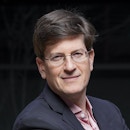Fundamental Bounds on the Fidelity of Sensory Cortical Coding
- Speaker
-
 Mark Schnitzer, Ph.D.Professor, Department of Biology and Department of Applied Physics , Stanford University
Mark Schnitzer, Ph.D.Professor, Department of Biology and Department of Applied Physics , Stanford University
Investigator, Howard Hughes Medical Institute
Presidential Lectures are a series of free public colloquia spotlighting groundbreaking research across four themes: neuroscience and autism science, physics, biology, and mathematics and computer science. These curated, high-level scientific talks feature leading scientists and mathematicians and are designed to foster discussion and drive discovery within the New York City research community. We invite those interested in these topics to join us for this weekly lecture series.
Perception is limited by the information that the brain can extract from the noisy dynamics of sensory neurons. In this lecture, Mark Schnitzer will present a new microscope to monitor neural activity across the primary visual cortex and analyses to quantify the information conveyed by large neural ensembles. The data reveal limitations on the accuracy of sensory cortical coding due to correlated fluctuations in neural dynamics.
Seminal experiments published three decades ago suggested that correlated activity fluctuations within sensory cortical neural ensembles are what limits their coding accuracy. However, without concurrent recordings from thousands of cortical neurons with shared sensory inputs, it has remained unknown whether correlated noise limits coding fidelity. Schnitzer and colleagues found that, in the mouse visual cortex, correlated noise constrained signaling for ensembles of 800–1,300 neurons. Moreover, neural ensemble visual signals were perpendicular to the largest noise mode, which, therefore, did not limit coding fidelity. The information-limiting noise modes were approximately 10 times smaller and concordant with mouse visual acuity. Cortical design principles appear to enhance coding accuracy by restricting roughly 90 percent of noise fluctuations to modes that do not limit signaling fidelity, whereas much weaker correlated noise modes bound sensory discrimination. His lab has invented several technologies now commercially available, including tiny microscopes that are small enough to be mounted on the head of a freely behaving mouse and that are currently used by more than 500 labs worldwide.
Further instructions and access to join the webinar will be sent to all registrants upon sign up.
Inquiries: lectures@simonsfoundation.org
